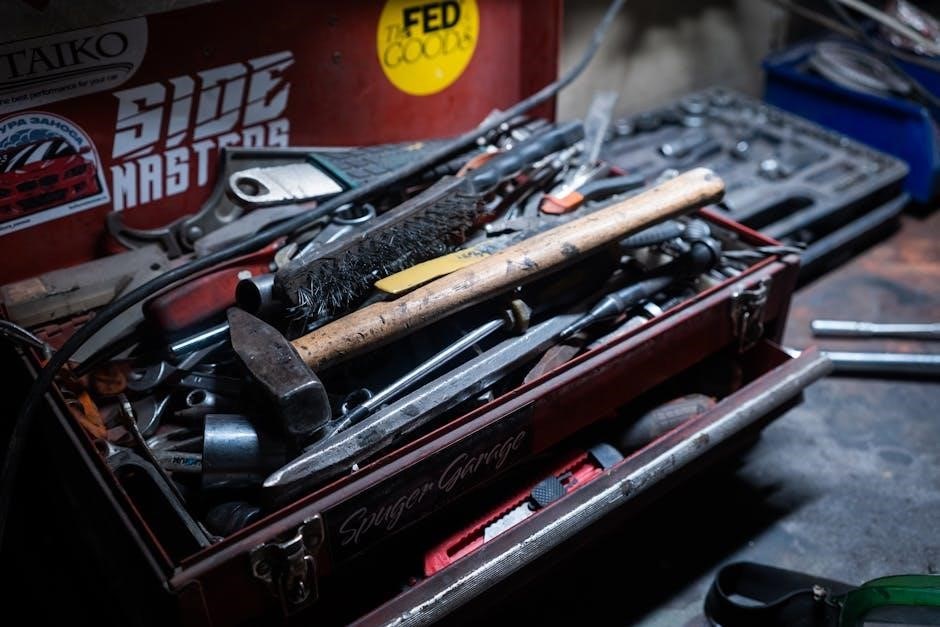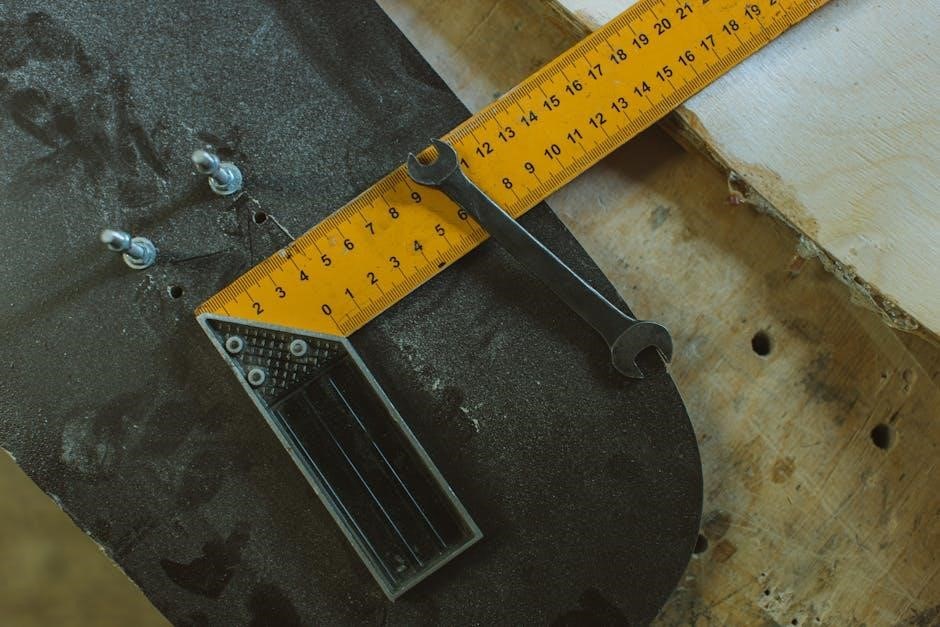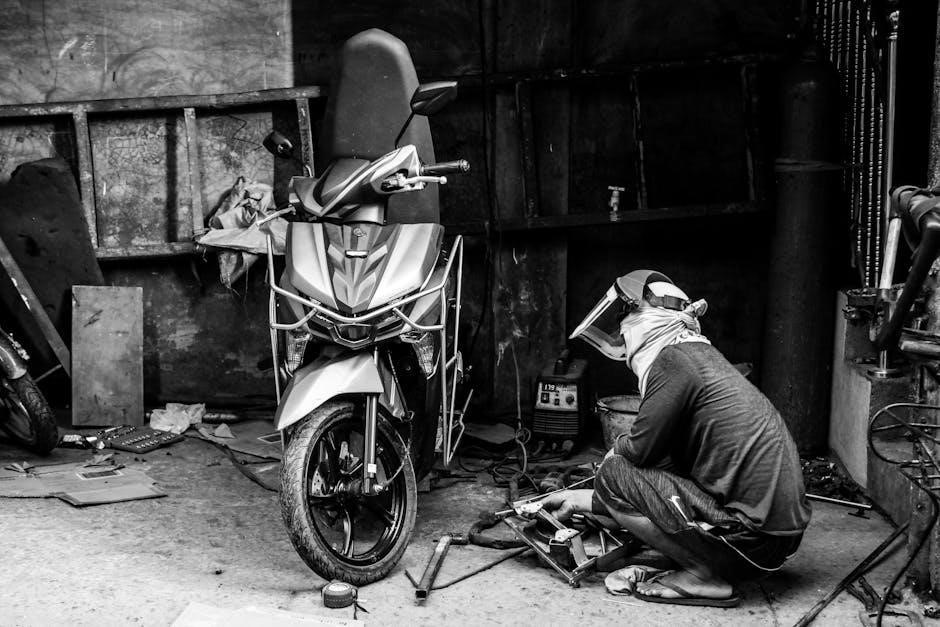This manual empowers users to maintain and repair their EW-36 scooter effectively. It provides essential safety guidelines, routine maintenance tips, and troubleshooting solutions for optimal performance.
1.1 Overview of the EW-36 Mobility Scooter
The EW-36 mobility scooter is a high-performance, recreational vehicle designed for enhanced mobility and comfort. Known for its durability and speed, it offers a unique blend of power and portability. This scooter is ideal for active individuals seeking independence and freedom in their daily activities. Its robust design and advanced features make it a popular choice for both urban and outdoor environments. The EW-36 is engineered to provide a smooth riding experience, ensuring safety and reliability for users.
1.2 Importance of the Repair Manual
The repair manual is essential for ensuring the longevity and optimal performance of the EW-36 mobility scooter. It provides detailed guidance on troubleshooting common issues, such as battery-related problems and brake malfunctions, enabling users to address concerns promptly.
By following the manual, users can perform routine maintenance, like checking tire pressure and adjusting brake tension, ensuring safety and reliability. It also serves as a comprehensive resource for advanced repairs, helping users avoid costly service calls and maintain their scooter independently.
1.3 Key Features of the EW-36 Model
The EW-36 mobility scooter is known for its advanced features, including a durable design and powerful motor, allowing it to handle various terrains with ease. It features deep-cycle, maintenance-free batteries that provide extended range and reliability.
The scooter also includes a robust braking system, ensuring safe and controlled stops. Additional features like a comfortable seat, safety belt, and intuitive controls enhance user experience, making it a reliable choice for daily mobility needs.

Safety Guidelines for Repair and Maintenance
Always disconnect power before repairs. Wear protective gear and ensure the scooter is stable. Avoid modifying components without authorization and consult the manual for detailed procedures.
2.1 Precautions Before Starting Repairs

Always wear the safety belt and ensure loose clothing or body parts are kept away from moving components. Disconnect the battery before starting any repairs to prevent accidental startups. Use only approved tools to avoid damaging the scooter’s electrical or mechanical systems. Ensure the scooter is on a stable, level surface and apply the parking brake. Wear protective gear, including gloves and safety glasses, to minimize risks. Never attempt repairs without consulting the manual first. Keep unauthorized modifications to a minimum to maintain warranty validity.
2.2 Safety Belt Usage and Maintenance
Always wear the safety belt while operating the scooter to ensure stability and control. Regularly inspect the belt for frays, cuts, or wear. If damaged, replace it immediately with an authorized part. Clean the belt with mild soap and water to maintain its integrity. Avoid altering or modifying the belt, as this can compromise safety. Properly secure the belt before starting the scooter to prevent accidents. Replace the belt if it shows signs of excessive wear or if it no longer fastens securely. Ensure it is compatible with your EW-36 model for optimal safety.
2.3 Proper Handling of Electrical Components
Always turn off the scooter and disconnect the battery before handling electrical components to prevent accidental startups or shocks. Use the wiring diagram in the manual to identify components correctly. Avoid exposing electrical parts to liquids, as this can cause malfunctions or corrosion. Regularly inspect wires and connections for wear or damage. Clean electrical contacts gently with a dry cloth to ensure proper conductivity. Never attempt DIY repairs without proper knowledge, as this can lead to further damage. Always consult the manual or a professional for complex electrical issues.

Routine Maintenance Procedures
Regular maintenance ensures optimal performance and longevity. Check brakes, tires, and battery health. Adjust components as needed and clean electrical contacts to maintain smooth operation and safety always.
3.1 Checking and Adjusting Brake Tension
To ensure safe operation, regularly check the brake tension on your EW-36 scooter. Start by turning the scooter off and engaging the parking brake. Inspect the brake cables for fraying or damage. Use an Allen wrench to adjust the tension by tightening the brake cable nuts. Test the brakes by gently moving the scooter. If the brakes feel too loose or tight, repeat the adjustment process. Always wear protective gloves during this procedure. Proper brake tension ensures reliable stopping power and rider safety. Refer to the manual for detailed diagrams and guidance; If unsure, consult an authorized technician.
3.2 Battery Care and Maintenance
Proper care of the EW-36 scooter’s battery is crucial for optimal performance and longevity. Use deep-cycle, maintenance-free batteries, such as sealed lead-acid or gel cells. Avoid overcharging, as it can reduce battery life. Regularly check the charge level and ensure the terminals are clean and secure. Store the battery in a cool, dry place when not in use. Always follow the charging instructions provided in the manual. If the battery is not holding charge, it may need replacement. Proper maintenance ensures reliable power and extended service life for your scooter.

3.3 Tire Pressure and Wheel Inspection
Regular inspection of the EW-36 scooter’s tires and wheels is essential for safety and performance. Check tire pressure monthly, ensuring it matches the manufacturer’s recommendations. Inspect tires for wear, cuts, or uneven tread. Clean debris from wheels to maintain proper balance. If damage is found, replace the tire immediately. Proper tire pressure enhances stability and ride comfort, while regular inspections prevent potential hazards. Always test the brakes after adjusting or replacing tires to ensure optimal functionality and safety while operating the scooter.

Troubleshooting Common Issues
Identify and diagnose issues like battery drained quickly, brakes malfunctioning, or electrical faults. Regular inspections and proper tools help resolve problems efficiently, ensuring smooth scooter operation always.
4.1 Diagnosing Battery-Related Problems
Identifying battery issues in the EW-36 scooter involves checking for low power, inconsistent charging, or failure to hold charge. Ensure the battery is fully charged and connections are secure. If problems persist, test voltage using a multimeter. Low voltage readings may indicate a faulty battery. Additionally, check for corrosion on terminals and clean them if necessary. If the battery is old or damaged, consider replacing it with a deep-cycle, maintenance-free option, as recommended in the manual. Always follow safety guidelines when handling batteries.
4.2 Identifying Brake System Malfunctions
Brake system issues in the EW-36 scooter can manifest as reduced stopping power or uneven braking. Start by checking the brake handle tension and connections. Ensure the brake lever operates smoothly and doesn’t feel loose. Inspect the brake pads for wear or contamination, and clean or replace them as needed. Check the brake cables for fraying or damage. If the scooter has a regenerative braking system, verify its functionality. Proper maintenance, such as lubricating moving parts and adjusting brake tension, can prevent malfunctions. Always refer to the manual for detailed procedures.
4.3 Addressing Electrical System Faults
Electrical issues in the EW-36 scooter often stem from faulty connections or damaged wiring. Start by inspecting the battery terminals and connections for corrosion or looseness. Check the wiring harness for visible damage or fraying. Use a multimeter to test for short circuits or open circuits in critical components like the motor controller or throttle. Ensure the fuse or circuit breaker is functioning properly. If issues persist, consult the wiring diagram in the manual. Always disconnect the battery before performing electrical repairs to avoid shocks or damage.

Advanced Repair Topics
Dive into expert-level repairs, including detailed wiring diagrams, component replacements, and customization tips to enhance your EW-36 scooter’s performance and extend its longevity.
5.1 EW-36 Wiring Diagram Explanation
The EW-36 wiring diagram provides a comprehensive guide to understanding the scooter’s electrical system. It illustrates the interconnections between components like the battery, motor, and control modules. This diagram is essential for diagnosing electrical faults and ensuring proper repairs. Users can identify cables, connectors, and circuits, making it easier to trace issues. The wiring diagram also highlights safety guidelines for working with electrical systems, such as disconnecting the battery before repairs. Referencing this diagram alongside the repair manual ensures accurate troubleshooting and maintenance, helping users avoid potential hazards and extend the scooter’s lifespan.
5.2 Replacing Faulty Components
Replacing faulty components on the EW-36 mobility scooter requires careful identification of the issue and proper tools. Start by diagnosing the problem using the troubleshooting guide. Once the faulty part is identified, ensure to purchase genuine or compatible replacement components. Disconnect the battery before starting any repair to avoid electrical hazards. Use the wiring diagram to locate connections and follow step-by-step instructions for removal and installation. Tighten all bolts securely and test the scooter after replacement. Always refer to the repair manual for specific procedures to ensure safety and maintain the scooter’s performance and warranty validity.
5.3 Upgrading or Modifying the Scooter
Upgrading or modifying the EW-36 mobility scooter can enhance performance and customization. Always consult the repair manual before making changes to ensure compatibility and safety. Modifications should be approved by the manufacturer to maintain warranty validity. Consider upgrading components like batteries for extended range or adding accessories for improved comfort. Ensure all modifications follow electrical and mechanical safety guidelines to avoid malfunctions. Proper documentation of changes is essential for future maintenance and troubleshooting. Always prioritize safety and stability when altering the scooter’s design or functionality.

Tools and Equipment Required
Essential tools include screwdrivers, wrenches, and a multimeter for electrical checks. A digital multimeter is crucial for diagnosing faults. A torque wrench ensures proper bolt tightening. Always use a repair manual for specific tool recommendations.
6.1 Essential Tools for Repairs
Essential tools for repairing the EW-36 mobility scooter include a set of Allen wrenches, screwdrivers (both Phillips and flathead), pliers, a torque wrench, and a multimeter for electrical diagnostics. A socket set and a tire pressure gauge are also necessary for adjusting brakes and checking tire pressure. Safety gear like gloves and safety glasses should always be worn. Keep a well-organized toolbox to ensure efficiency and avoid losing small parts. Refer to the manual for specific tool recommendations to avoid damaging components during repairs.
6.2 Recommended Diagnostic Equipment
For effective troubleshooting, use a multimeter to check electrical connections and battery voltage. A circuit tester helps identify wiring issues, while a battery tester ensures optimal charge levels. An LED light tester is useful for tracing wiring problems without damaging components. Additionally, a tire pressure gauge is essential for maintaining proper tire inflation, which affects both performance and safety. These tools enable precise diagnostics, ensuring your EW-36 scooter operates efficiently and reliably over time.
6.3 Safety Gear for Protection
Protective equipment is crucial when performing repairs on the EW-36 mobility scooter. Always wear safety gloves to prevent cuts and abrasions. Safety glasses or goggles shield your eyes from debris. A dust mask is essential when handling electrical components or cleaning dusty areas. Steel-toe boots provide foot protection from heavy tools or falling parts. Ensure proper ventilation in your workspace to avoid inhaling fumes from chemicals or batteries. Using the correct safety gear minimizes risks and ensures a safe repair process for both you and the scooter.

Step-by-Step Repair Instructions
This section provides a detailed guide for disassembling, diagnosing, and reassembling the EW-36 scooter. Follow the instructions carefully to ensure safe and effective repairs.
7.1 Disassembling the Scooter
Start by disconnecting the battery and wearing protective gear. Remove the seat and dismantle the tiller for easier access. Use an Allen wrench to detach the handlebars and a screwdriver for side panels. Carefully label and organize screws to avoid misplacement. Gently pull apart components, ensuring wires remain intact. Document each step for reassembly reference. Avoid forcing parts, as this may damage internal mechanisms. Handle electrical components with caution to prevent short circuits or injuries. Store disassembled parts securely to maintain order and safety throughout the process.
7.2 Reassembling After Repairs
Reassembly requires precision to ensure functionality. Begin by reversing the disassembly steps, starting with the tiller and handlebars. Reattach the seat securely and reconnect electrical components, verifying all wires are properly linked. Align parts carefully to avoid misalignment. Tighten screws firmly but avoid over-tightening. Reconnect the battery last and test the scooter’s controls. Ensure brakes function correctly before full operation. Double-check all components for stability and proper alignment. A thorough inspection post-reassembly ensures safety and optimal performance. Refer to the manual for specific torque specifications and wiring diagrams.
7.3 Testing the Scooter Post-Repair
After reassembly, thoroughly test the scooter to ensure all systems function correctly. Begin with a static test: check brakes, lights, and controls. Next, perform a slow-speed test in a controlled environment to verify stability and responsiveness. Gradually increase speed to assess performance under normal conditions. Test the scooter on both flat and inclined surfaces to evaluate power and balance. Inspect for any unusual noises or vibrations. Ensure all electrical components, such as the throttle and brakes, operate smoothly. Document any issues for further adjustment or repair.

Warranty and Service Information
Understand your scooter’s warranty coverage and locate authorized service centers for professional assistance. Keep detailed documentation for repair claims to ensure smooth processing and compliance with manufacturer guidelines.
8.1 Understanding the Manufacturer’s Warranty
The EW-36 mobility scooter is backed by a manufacturer’s warranty that covers defects in materials and workmanship for a specified period. It is essential to review the warranty terms to understand what is covered and what is excluded. Typically, the warranty does not cover damage caused by misuse, unauthorized modifications, or normal wear and tear. Users should ensure all repairs are performed by authorized technicians to maintain warranty validity. Always refer to the official manual for detailed warranty conditions and duration. Proper documentation and registration may also be required for warranty claims.
8.2 Finding Authorized Service Centers
To ensure your EW-36 mobility scooter is serviced correctly, locate an authorized service center through the manufacturer’s official website or contact customer support. These centers have trained technicians and genuine parts to maintain your scooter’s performance. Always verify the center’s authorization to avoid voiding your warranty. Proper documentation and prior approval may be required for repairs. Using authorized centers ensures compliance with warranty terms and guarantees high-quality service. Keep records of all maintenance for future reference and potential warranty claims.
8.3 Documentation for Repair Claims
Proper documentation is essential for processing repair claims under the EW-36 warranty. Maintain detailed records of maintenance, repairs, and parts replacements. Include receipts, service reports, and communication with authorized centers. Submit claims with a copy of the warranty, proof of purchase, and a description of the issue. Ensure all repairs are performed by authorized technicians to avoid voiding the warranty. Keep organized files for quick access and verification. Accurate documentation ensures smooth processing and adherence to warranty terms, preventing delays or claim denials.
Regular maintenance ensures optimal performance and longevity of your EW-36 scooter. Always follow safety guidelines and troubleshooting tips for a smooth and reliable mobility experience.
9.1 Summary of Key Maintenance Practices
Regular maintenance is crucial for the EW-36 scooter’s longevity. Always check battery charge levels, ensuring deep-cycle batteries are used. Inspect tires for proper pressure and wear. Brake tension should be adjusted as needed, and safety belts must be worn. Keep electrical components clean and dry, avoiding modifications without authorization. Refer to the manual for detailed guidance and schedule routine servicing to prevent issues. Consistent care ensures reliability, safety, and optimal performance of your mobility scooter.
9.2 Encouragement for Regular Servicing
Regular servicing is crucial for extending the life of your EW-36 mobility scooter. Schedule frequent check-ups to ensure optimal performance and safety. Always refer to the repair manual for guidance on maintenance tasks. Proper care, such as checking brakes and adjusting tension, prevents potential issues. Use diagnostic tools to identify faults early. Encourage users to follow the manual’s recommendations for battery care and electrical system checks. Regular servicing not only enhances reliability but also ensures your scooter remains safe and efficient for daily use. Consult professionals if unsure about any procedure.
9.3 Resources for Further Assistance
For additional support, refer to the official EW-36 mobility scooter repair manual PDF or visit the manufacturer’s website. Authorized service centers offer professional guidance and repairs. Contact customer support for inquiries or troubleshooting. Online forums and repair communities can also provide valuable insights. Always ensure any modifications or repairs adhere to the manufacturer’s guidelines to maintain warranty validity and safety standards. Utilize diagnostic tools recommended in the manual for accurate assessments and solutions.



